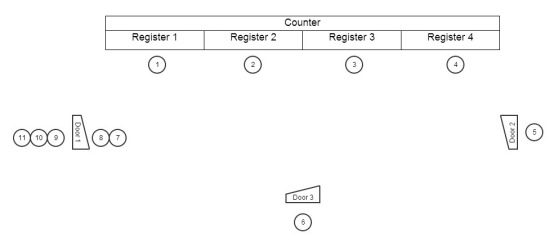
Photo credit: http://photos.jdhancock.com/
We learned this in kindergarten, right? You would think so, but I’ve seen too many examples recently where people haven’t learned anything new since that first line experience. So here is an apparently much-needed primer for how to form a line. Let’s assume that if you are in a line with only one entry point, everyone will remain appropriately single file.
However, what if there are multiple variables? Here is where it gets tricky for some of our species. Let’s look at two ways to organize ourselves without an authority figure directing us.
Example 1
Here we have 3 doors, helpfully labeled Door 1, Door 2, and Door 3. We also have a counter with 4 registers and 11 customers. You might think of this as a fast food restaurant during a busy lunch hour. In this example, the customers have decided to organize themselves by forming a single line that begins a few steps inside of Door 1 on the left.
Customers coming in Doors 2 and 3 are quickly confused by the customers obviously waiting out the door while there is plenty of open space in front of multiple registers. They are courteous people and so they attempt to get in line with those in Door 1, although they have no idea who was there before them.
Further complicating this mess is that customer #7, the next customer ‘in line’ is busy texting and unaware of repeated calls for the next customer when a register opens. This one person is now holding up business for the restaurant owner and wasting everyone’s lunch hour. It’s not entirely his fault though; this could easily be remedied if these lines were better managed.
Example 2
In this example, the customers have decided to form multiple lines, one at each register. This is an important leap in imagination, as it solves many of the problems caused by Example 1. For instance:
- Customers entering from Doors 2 and 3 can immediately understand where they should go in order to place an order efficiently. We can guess the next customer to come in will go to Register 1 because it has the shortest line.
- It restores the ‘first come, first served’ principles because no one has to guess if someone was in line before them or not. In Example 2, it is clear which customers arrived first.
- Customers 9, 10 and 11 are not left to stand outside on a hot summer day, as they are forced to do in Example 1. In addition, the restaurant is better able to manage their inside temperature because the doors are not open to outside due to the line.
- Because the lines are immediately in front of the registers, it is easy for an employee to speak to someone normally and say ‘May I take your order?’ instead of having multiple employees shout toward Door 1 “I can take the next customer! I can take the next customer!” This eliminates the waiting caused by the person who has decided to text instead of order lunch.
- Even if there is someone who essentially refuses to order, all customers in other lines continue moving and do not feel they are cutting the line by ordering at another register. So if Customer 2 at Register 2 is unaware it is their turn, it only affects Customers 7 and 11 behind them. In Example 1, it would bottleneck every customer and every register until they have stepped to a register.
Does this seem obvious to you? If so, congratulations! You are an elite member of our American society. If the above examples perplex you, please study them as long as needed until you are able to enter a fast food restaurant and order without becoming angry at those who already understand these concepts.
**Extra credit to those who are able to apply these principles to other scenarios, such as a busy men’s restroom at a ballgame or other such environments.

